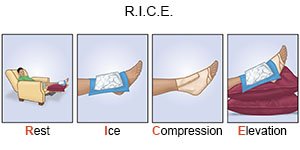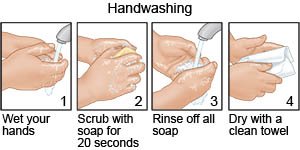Brown Recluse Spider Bite: Symptoms, Diagnosis, Treatment
The bite wound may heal on its own, but you will need treatment if the wound gets worse. It is important to clean the wound site with soap and water. You may need any of the following:
Brown Recluse Spider Bite
Medically reviewed by Drugs.com. Last updated on Jan 5, 2023.
What do I need to know about a brown recluse spider bite?
Brown recluse spiders are venomous. The venom may cause severe skin and tissue damage after several hours or days.
What are the signs and symptoms of a brown recluse spider bite?
You may not feel anything at first. Within hours of the bite, you may feel mild burning or irritation in the bite wound. You may have any of the following:
- Severe swelling and pain at the site
- Blister that is blue in the center and ringed by redness
- Pimple-like lesion with yellow or green pus
- Ulceration (break in skin or mucous membrane)
- Rash that itches
- Dark urine
- Fever, chills, nausea and vomiting, or seizures
- Joint pain
How is a brown recluse spider bite diagnosed?
Your healthcare provider will ask about your symptoms and examine the injured area. He or she may ask about your medical history. You may need to have blood or urine tests or a skin biopsy. If you are able to capture the spider safely, bring it to your provider.
How is a brown recluse spider bite treated?
The bite wound may heal on its own, but you will need treatment if the wound gets worse. It is important to clean the wound site with soap and water. You may need any of the following:
- Medicines may be given to help prevent or treat pain, itching, or a bacterial infection. There is no antivenom available for a brown recluse spider bite. You may also need a booster vaccine called Td if it has been at least 10 years since your last dose. The Td vaccine helps prevent tetanus. Tetanus is a disease that can develop after a puncture wound.
- Surgery may be done if the damaged tissue around your wound becomes large and needs to be removed. Your healthcare provider will clean the area and remove dead tissues to help the wound heal faster.
- Hyperbaric oxygen therapy used to get more oxygen into your body. The oxygen is given under pressure to help it get into your tissues and blood. You may need to have this therapy more than 1 time.
How do I care for the bite area?
 |
- Rest the area as directed to help your wound heal.
- Ice the wound. Ice helps decrease swelling and pain. Put ice in a plastic bag. Wrap the bag with a towel and put it on the site of the spider bite for 10 to 20 minutes.
- Compress the wound. A compression bandage around the wound can reduce pain and swelling.
- Elevate the wound. Keep the bite area above the level of your heart to help decrease redness and swelling. If you were bitten on the arm or leg, prop it on pillows to keep the area elevated comfortably.
- Wash your hands before and after you take care of your wound.

- Clean your wound with mild soap and water. Pat the area dry. Do not rub the wound. Clean your wound as often as directed by your healthcare provider. If you cannot reach the wound, have someone help you.
- Carefully check the wound and the area around it. Watch for more swelling, redness, or fluid oozing out. Apply gentle pressure to stop any bleeding.
- Cover your wound with a layer of sterile gauze bandage or other dressing as directed by your healthcare provider. If the bandage should be wrapped around your arm or leg, wrap it snugly but not too tight. It is too tight if you feel tingling or lose feeling in that area. Keep the bandage clean and dry.
How can a I prevent a brown recluse spider bite?
- Recognize the spider. Brown recluse spiders are usually brown and have a pattern on the back that looks like a violin.
- Learn where to find them. Brown recluse spiders live in the central and southern parts of the United States. They can be found from April to October and are active at night. They prefer to live in dark, warm, dry places. Some examples are under rocks, boards, and woodpiles, in dark corners, and under furniture.
- Use caution. Brown recluse spiders are not aggressive. They bite people only when threatened. Make noise when you enter attics or other spaces where spiders may live. Noise may scare them away. Use caution when you remove a web or spider.
- Be proactive. Clean closets, sheds, and attics completely. Shake out clothes or shoes that are lying on the floor or stored before you put them on. Check your sheets before you get into bed. Remove woodpiles and other trash from outside areas, especially piles where spiders can live. Wear gloves, long sleeved shirts, pants, and shoes when you work near wood or garbage piles.
Call your local emergency number (911 in the US) if:
- You have trouble talking, walking, or breathing.
When should I seek immediate care?
- You have a fever or chills.
- The skin around your wound gets red, or the wound gets more painful.
- You have a headache or nausea with vomiting.
- You have numbness or tingling in the bite area.
- Your urine is darker, or you urinate less than is usual for you.
- Your wound does not stop bleeding even after you apply pressure.
- Your wound or bandage has pus or a bad smell.
When should I call my doctor?
- You have a rash, itching, or swelling after you take your medicine.
- The bite becomes red and swollen.
- You have pain or problems moving the injured part or get tender lumps in the groin or armpits.
- Your wound continues to get larger.
- You have questions or concerns about your condition or care.
Care Agreement
You have the right to help plan your care. Learn about your health condition and how it may be treated. Discuss treatment options with your healthcare providers to decide what care you want to receive. You always have the right to refuse treatment. The above information is an educational aid only. It is not intended as medical advice for individual conditions or treatments. Talk to your doctor, nurse or pharmacist before following any medical regimen to see if it is safe and effective for you.
© Copyright Merative 2022 Information is for End User’s use only and may not be sold, redistributed or otherwise used for commercial purposes.
Learn more about Brown Recluse Spider Bite
Care guides
- Black Widow Spider Bite
- Snake Bite
Further information
Always consult your healthcare provider to ensure the information displayed on this page applies to your personal circumstances.
Brown Recluse Spider Bite: Symptoms, Diagnosis, Treatment
A bite from a brown recluse spider can be mild or severe and may require medical attention. The toxins from this spider’s bite can cause tissue death.
Bites from the brown recluse spider almost never result in death but can cause serious skin damage, nausea, and muscle pain. With proper care, mild bites resolve within days to weeks, while more severe cases can take months to heal.
A bite from the brown recluse spider requires first aid, and if necessary, professional medical attention. Treatment often includes cleaning the affected skin, pain relievers, and icing.
Keep reading to learn the symptoms and stages of a brown recluse spider bite, how to identify the spider, and when to seek help.
What’s in the bite?
Even though this spider’s size maxes out at about a half-inch, its venom is more toxic than that of a rattlesnake. Luckily, the brown recluse is only capable of releasing a little into our system.
Here are two key toxins in the venom:
- Sphingomyelinase D has the potential to destroy skin tissues.
- Hyaluronidase can speed the venom’s penetration into tissue.
A brown recluse’s venom can destroy blood vessels, tissue, and nerves. As a result, the skin tissue can die, a phenomenon called skin necrosis.
In a 2020 study of 97 patients bitten by the spider, 40 percent experienced hemolysis, the damaging or breaking down of red blood cells.
Prompt treatment can slow these effects and allow your skin to begin healing faster.
Initial bite
Brown recluses have very small fangs, and their bite is usually painless. Unless you saw it happen, at first, you might not even be aware that a spider has bitten you.
You may start to notice a red, tender, and inflamed area about 2 to 8 hours after the spider bit you. Over the course of the next several hours, the irritation may cause a burning sensation.
The bite may appear as two tiny puncture holes . Early on, its center will be a pale color, with an inflamed reddish outer ring. The pain usually reaches its height at about the 24-hour mark after you are bitten.
After 3 to 5 days
In some people, the brown recluse’s venom is localized to only the area where the spider bit you. If the spider injected minimal venom and you’re healthy, the discomfort usually goes away in a few days.
But for others, the venom spreads. This causes the wound to expand, usually over a period of several days to weeks. Some people will develop a blister, and then a “necrotic lesion” due to the spider’s bite. This means the bite causes an ulcer or open sore, and tissue begins to die.
This may look like the following:
- dry, sinking patch of skin
- bluish-appearing patch of skin
- redness around the lesion with a pale center
- central blister
After 1 to 2 weeks
For mild bites, you should be mostly healed by 3 weeks or see a drastic reduction in inflammation.
But if you have a more severe bite, the spider’s toxin will continue to break down the skin, especially if untreated. The site of the wound may start to develop necrotic (dead) tissue called eschar. This looks like a big, black scab covering the wound area.
3 months later
Most brown recluse bites will heal fully, without complications, in 3 months or less.
In very rare cases where a lot of venom was delivered, necrosis in the wound can extend beyond the skin and into the muscles. If tissue death continues to occur or has already affected a large area, you’ll need to be evaluated by a surgeon. Surgery may be required to remove or repair excess dead tissue.
If the wound hasn’t responded to treatment or symptoms don’t align with the typical presentation of a brown recluse bite, it may be time for a differential diagnosis. Your doctor will consider other potential culprits of your symptoms, like another type of insect bite or a separate skin condition.
Severe reactions to a brown recluse spider bite
Some people have severe or life threatening reactions to brown recluse bites. These responses to the bite are more likely in those with compromised immune systems, including children and older adults.
Severe reactions to a brown recluse bite can include the following symptoms:
If you or a loved one is experiencing the above symptoms, seek emergency medical assistance. This may be a sign of anaphylactic shock, a life threatening allergic reaction.






